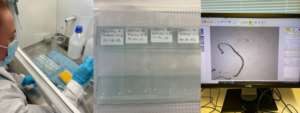Hi! My name is Ragnhild Hestness and I’m in my 8th semester in the integrated teacher program at the University of Bergen. My education will make me able to become a teacher in biology and chemistry at the High School level, but I still haven’t decided if I want to go in that direction or if I want to use my education to work as a biologist. I have always had a special interest for the ocean and an urge to understand more about the creatures living there. I was recommended to take the course BIO299 by my master supervisor, because it gives me a great opportunity to learn lab protocols important for my master.
Background
The background for my project is a larger project that takes please at the developmental biology lab at the University. The project focuses on the use and effect of narrow banded LED light on development and performance of Atlantic salmon (Salmo salar). One of the work-packages in this project focuses on clock genes, and my contribution in this work-package will be used in the larger project.
What are clock genes?
Organisms perceive time using a built-in mechanism called the biological clock. This clock ensures that reactions and physiological processes in the organism are synchronized with environmental changes and the day/night cycle on earth. It tells an organism when to sleep, eat and mate, and it affects growth, development and reproduction. Studies have showed that the biological clock derives from a molecular oscillator assembled form a regulatory set of genes called clock genes. Transcription-translation feedback loops (figure 1) of the clock genes make a rhythm where mRNA levels and proteins oscillate on a 24-hour basis, which again regulate many biological processes in the organism, such as sleep.
Aim of study
The aim of the study was to screen for clock genes in the brain and retina of Atlantic salmon. The salmon was at the developmental stage before start-feeding (740dd).
What we did
I conducted the mounting, sectioning and the In situ hybridization of the fish larvae and followed the process all the way from the preparation to the analysis of the results. The work was done in the developmental biology lab at the University and I got really good training and follow-up by my supervisors. Figure 2 shows the overview of the procedures done in the lab. The In-situ hybridization (ISH) is a principle where you can detect mRNA in cells by using a complementary RNA probe with a marker (figure 3). If the mRNA you search for is present, the two probes will hybridize, and you can detect the marker in the tissue (purple color).
The protocol for ISH takes 3 days in the lab and includes many steps with different solutions. Figure 4 shows some pictures form the lab work we did under the ISH.

Figure 4: Pictures from some of the lab work showing the application of probes to sections, overview of the sections and analysis of the sections
What we found
Of the nine clock genes we screened for we found expression of three of them in the brain of the Atlantic salmon. Figure 5 show how the expression of a gene look like on a brain section
We also screened for some opsins which is proteins that are found in photoreceptor cells, that are light-sensitive. The reason for this was that we looked for a correlation between light sensitive cells and the biological clock, as a part of the larger project that studies the effect of light on the Atlantic salmon.
What have I learned?
This project gave me a great opportunity to experience how it is to work with research in a lab, and it gave me valuable training in different lab procedures and protocols. My interest in ocean species and especially salmon have been strengthened during this course, and I am looking forward to learning even more during my master.
Thanks for reading!
Greetings, Ragnhild



